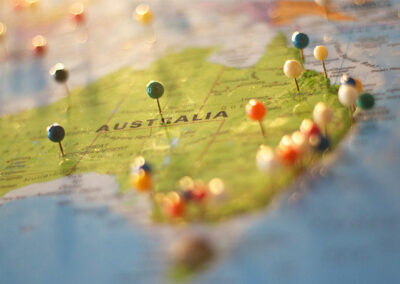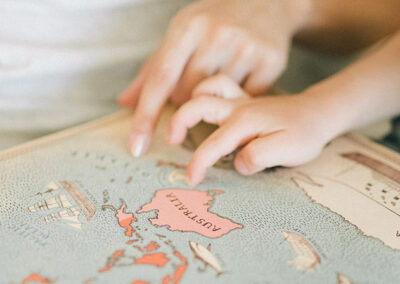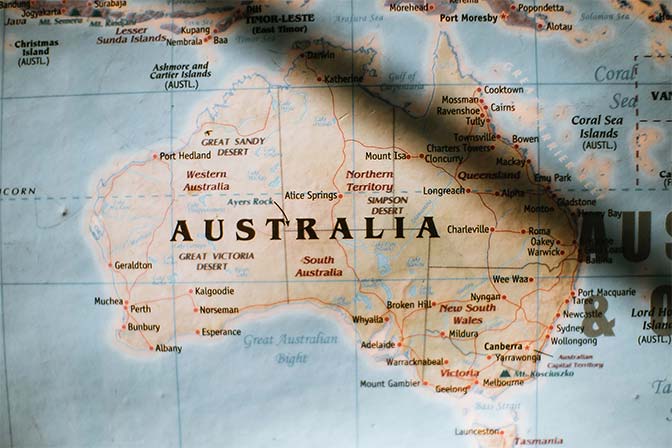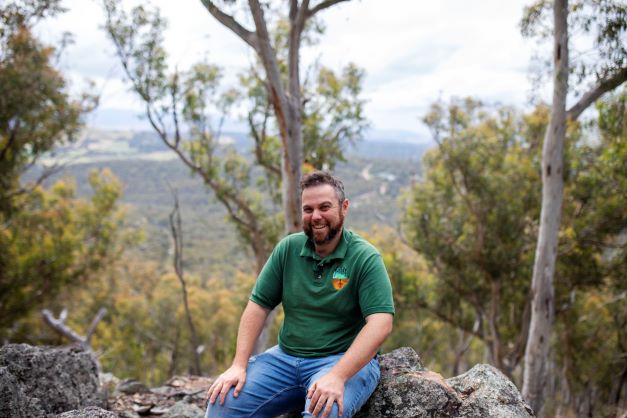LEARNING ACTIVITY
STORY
Jarrah was telling Adam that his older cousin Ricky is moving to Geraldton in Western Australia. “It is so far away from where I live” said Jarrah, “I’m going to miss him. Hmmm, be good to know who the local mob is over there, do you know Adam?”
Adam said “I don’t know, I have heard of the Noongar people but I think they are located around Perth, that’s a long way south from Geraldton. However, what Ricky needs to do is connect with the local people when he arrives through local community centres and events. Ricky should introduce himself, tell them where he is from and then ask who is their local tribal group.” Jarrah is looking forward to hearing from Ricky once he settles into Geraldton. It will be great to catch up with him and find out about the local mob living in Geraldton and their special places and language.

This activity introduces the Aboriginal and Torres Strait Islander peoples as the First Nations peoples of this Country. They are the traditional custodians of the lands, waterways and skies across Australia and that it is important for us to recognise that.
A Welcome to Country and an Acknowledgement of Country are opportunities for all people that show respect to Aboriginal and Torres Strait Islander peoples and cultures, and build an understanding of their languages and connections to Country.
Anyone can do an Acknowledgement of Country to acknowledge the country that they are on. Only an Elder from that Country can do a Welcome to Country.
Learning about Aboriginal and Torres Strait Islander languages can help children build their understanding of land, water and people. This activity helps to assist the identification of the language group/s on which the school or home is situated.
To understand local perspectives and support these activities, we recommend reaching out to the local Traditional Owners and First Nations peoples who can assist in knowledge sharing and understand local land, histories and culture. This is an important consideration to ensure that any reconciliation initiatives are being driven in a local and meaningful way.
For children to:
- understand that the Aboriginal and Torres Strait Islander peoples are the traditional custodians of Australia’s land, waterways and skies
- learn that Australia is made up of many different communities of First Nations peoples and there is a variation between and within each group
- appreciate the diversity of Aboriginal and Torres Strait Islander peoples across Australia identify the language group in their local area.
This activity can be done at any time of the year.
Introduction
Adam Shipp a Wiradjuri man shares the following.
“Language is a part of everything we do. It is in our country, our rocks, trees and landscapes. For Aboriginal and Torres Strait Islander people, it is important for us to connect and reconnect to the language of our ancestors and to speak this language every day. We believe our ancestors are always watching over us, so to speak our native tongue is to connect directly to them.”
Checklist
Instructions

STEP 1
Begin this activity at your location with an Acknowledgement of Country. By acknowledging the Land, you are also making a promise that you will care for the land, the waterways, the plants and the animals.
Use the story to encourage the students to talk about their understanding of First Nations languages. What did they learn from the story? What do they know about the languages of First Nations peoples? Have they heard anyone speak in these languages? Do they know some words for their local language group?
Can First Nations students share some language from their own culture with the others?

STEP 2
Use the online Gambay First Languages Map to explain the significance of language. Tell the learners that each language group had and still has, an important relationship with their Country and between Countries. No part of Australia was empty or without people. Language is important for identity.
Compare the language map with a political map of Australia showing the States and Territories.
How are they different? Compare the sizes of the groups? Why would they be different sizes? How would the groups differ across Australia?
What role would the type of environment and climate play in where people live?

STEP 3
Take some time outside with the students to sit quietly and listen for 2 minutes.
Is there an environmental sound that they heard that they have heard before – or that they like to hear? How could they look after the land they are on to ensure that these natural sounds can continue?
How they might behave to show respect for the land and Country they are on? What other ideas do they have and what actions can they take?
Discuss that an Acknowledgement of Country is way of showing respect for the Aboriginal or Torres Strait Islander Traditional Owners and Custodians of the land on which learning is taking place or a meeting or event is being held.

STEP 4
Find the location of where you are on a map of Australia. Find that location on the language map to find the name of the group for where you are located.
Not only are there many different First Nations communities across Australia, there is a great diversity of languages and therefore diversity of cultures. These languages are complex and as diverse as the people.
Use the activity sheet to write the location of where you live, and the language group of that place. You can also write the language groups for each Australian capital city. Write an Acknowledgement of Country for where you live. Find the language group for some other locations of your own choice.
Extension Activity
Extension 1
Research the First Nations peoples language in your local area for native plants and/or animals. Contact a local Elder and use the resources provided to help you with the research. You could use this information to help design the signage for your Indigenous plant-use garden.
Extension 2
Practice saying words from your local First Nations peoples language group. What ways can you incorporate this language into your everyday life?
Curriculum and Framework Links
ENGLISH
Year 7: ACELT1619
GEOGRAPHY
Year 8: ACHGK049
Year 9: ACHGK065
Year 10: ACHGK072
SCIENCE
Year 7: ACSHE223
Year 8: ACSHE226
BIOLOGY
Year 11: ACSBL011
CROSS CURRICULUM PRIORITY
Aboriginal and Torres Straight Islanders Histories and Cultures
Sustainability
GENERAL CAPABILITIES
Literacy
Numeracy
Critical and Creative Thinking
Personal and Social Capability
Ethical Understanding
Intercultural Understanding
Reference List
The maps provided here are representations only. We encourage you to connect and consult with your local Aboriginal and Torres Strait Islander community for appropriate language advice.
ONLINE RESOURCES
The Narragunnawali Aboriginal and Torres Strait Islander Languages, My Acknowledgement of Country (Secondary) and Languages Map (Secondary) curriculum resources on the Narragunnawali platform provide resources and activities on the practice of Acknowledging Country and use of Aboriginal and Torres Strait Islander language maps.
First Languages Australia is working with regional language centres nationally in the development of this Gambay – First Languages Map of Aboriginal and Torres Strait Islander languages that reflects the names and groupings favoured by community.
Learn more about the Gambay – First Languages Map from ABC Education.
You can view the AIATSIS map of Indigenous Australia and look more closely using a magnifier to find language, tribal or nation groups of First Nations peoples.
The National Indigenous Languages Report is a key achievement through Australia’s participation in the United Nation’s 2019 International Year of Indigenous Languages.
PRINTABLE RESOURCES
Aboriginal Australia Wall Map from AIATSIS (D R Horton)
APPLICATION
The Welcome to Country App (Apple) provides a short video Welcome to Country of a Traditional Owner or Elder.
WATCH
Bruce Pascoe shares the importance of young people contributing to building the language names for plants from in this video from ABC Education. (2 minutes)
READ
Engage with books in Aboriginal and Torres Strait Islander people’s language from Magabala Books, a publishing house owned and led by First Nations peoples.
NETWORK
We recommend reaching out to the Local Traditional Owners and First Nations peoples community groups who can assist in knowledge sharing and understanding local land, language, stories and culture. To reach out or find contacts in your local community you could speak to parents of First Nations students, to an Indigenous Learning Officer (ILO) at your school, local Land Council or a local Landcare group.
Engaging with these resources can contribute to a wider school and community reconciliation initiatives, including a schools Reconciliation Action Plan (RAP).
We have some suggested organisations to approach listed on our Junior Landcare Community page and in more detail within our Educator Notes.
Why not try one of our other Junior Landcare learning activities?
Creating an Indigenous plant-use garden: plant list
First Nations Perspectives
Creating an Indigenous plant-use garden: resources from the bush
First Nations Perspectives
Love Letters to the Land
Biodiversity|First Nations Perspectives|Food Production|Waste Management
Creating a yarning circle: involving First Nations people
First Nations Perspectives



